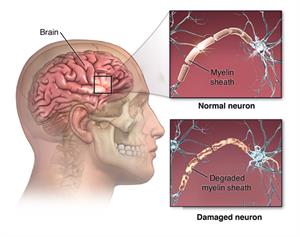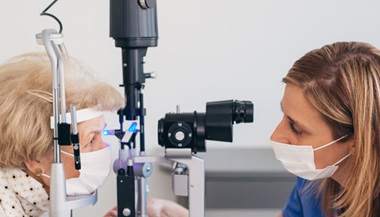Neuromyelitis Optica
What is neuromyelitis optica?
Neuromyelitis optica (NMO) is a rare autoimmune disease that affects the central nervous system. It's also called neuromyelitis optica spectrum disorder (NMOSD) or Devic's disease. NMO specifically affects the myelin, which is the insulation around the nerves. NMO mainly affects the spinal cord and the optic nerves—the nerves that carry signals from the eyes to the brain. As a result, the disease can cause paralysis and blindness.
The onset of NMO varies from childhood to adulthood, with two peaks, one in childhood and the other in adults in their 40s. Women are more often affected than men.
Experts used to think that NMO was a type of multiple sclerosis. They now think it may be a different condition. The conditions do have some similar symptoms, however they are usually more severe in NMO. Vision problems with multiple sclerosis usually affect 1 eye at a time, while NMO may affect both eyes at the same time.
There are 2 types of NMO:
-
Relapsing form, which has periodic flare-ups, with some recovery in between. This is the more common kind. Women are far more likely to have this form than men.
-
Monophasic form, which involves a single attack that lasts a month or 2 then may be free from attacks for several years. Men and women get this type equally.
What causes neuromyelitis optica?
With NMO, your immune system attacks a substance in your body called myelin—the insulation around your nerves. Specifically, the myelin cells in the spinal cord and optic nerves are attacked. Usually, people with NMO have flare-ups of the disease that may strike months or years apart. Between these flare-ups, people may have some recovery.
What are the symptoms of neuromyelitis optica?
These are possible symptoms of NMO:
-
Pain in the eyes
-
Loss of vision
-
Weakness or numbness in the arms and legs
-
Paralysis of the arms and legs
-
Difficulty controlling the bladder or bowels
-
Uncontrollable vomiting and hiccups
How is neuromyelitis optica diagnosed?
Your healthcare provider may do a variety of tests if they suspect NMO, such as:
-
MRI scan of your brain and spinal cord
-
Tests to check on how well your optic nerves are working
-
Samples of your blood and spinal fluid to check for signs of the disease
How is neuromyelitis optica treated?
Experts don't consider this condition curable. But your healthcare provider can prescribe medicines or other treatments to reduce the effects of the disease and relieve symptoms. These may include:
-
Corticosteroid medicines to halt the immune system's effect on your nerves
-
Immunosuppressant medicines
-
A process called plasmapheresis, also known as plasma exchange, which removes harmful antibodies from the blood that may be playing a role in the condition
-
Other treatments to address symptoms such as pain and loss of bowel and bladder control
You may also need help to cope with blindness and paralysis.
What are possible complications of neuromyelitis optica?
There are several possible complications of NMO including:
-
Visual impairment or blindness
-
Paralysis or weakness of 1 or more limb
-
Stiffness or muscle spasms
-
Loss of bowel or bladder control
-
Depression
-
Fatigue
Living with neuromyelitis optica
Disability from NMO may become worse over time. Most people with NMO develop weakness in their arms and legs. Others may have more severe symptoms. Some people with NMO need to start using a ventilator. This is a machine that helps them breathe. They may also need to work with an occupational therapist or social worker to address their disabilities.
If you or a family member is diagnosed with NMO, it is important to build a support system that includes family, friends, professionals, and support groups. A person with major disabilities may need the support of neurologists who specialize in NMO, occupational therapists, physical therapists, and social services professionals.
When should I call my healthcare provider?
Call your healthcare provider or seek medical care right away if you:
-
Notice sudden changes or find you need more help than usual
-
Have a change in mood
-
Have symptoms of depression or feelings of suicide
Key points about neuromyelitis optica
-
NMO is a rare but serious disease that affects the central nervous system. NMO mainly affects the spinal cord and optic nerves.
-
There is no cure. But there are medicines and treatments that may inhibit future disease flares.
-
Many healthcare providers, including physical and occupational therapists and social workers, can help you deal with your disease.
Next steps
Tips to help you get the most from a visit to your healthcare provider:
-
Know the reason for your visit and what you want to happen.
-
Before your visit, write down questions you want answered.
-
Bring someone with you to help you ask questions and remember what your provider tells you.
-
At the visit, write down the name of a new diagnosis and any new medicines, treatments, or tests. Also write down any new instructions your provider gives you.
-
Know why a new medicine or treatment is prescribed and how it will help you. Also know what the side effects are.
-
Ask if your condition can be treated in other ways.
-
Know why a test or procedure is recommended and what the results could mean.
-
Know what to expect if you do not take the medicine or have the test or procedure.
-
If you have a follow-up appointment, write down the date, time, and purpose for that visit.
-
Know how you can contact your provider if you have questions.






